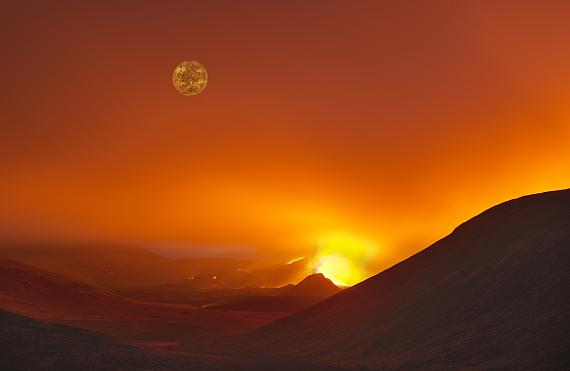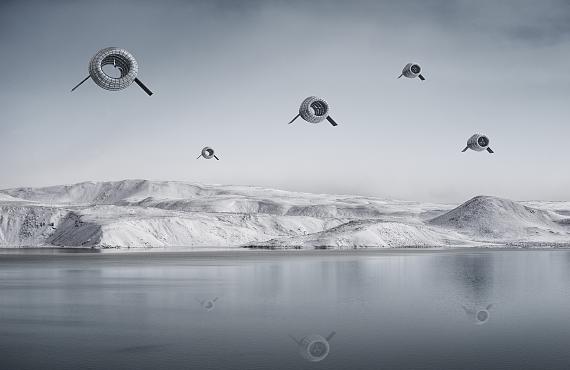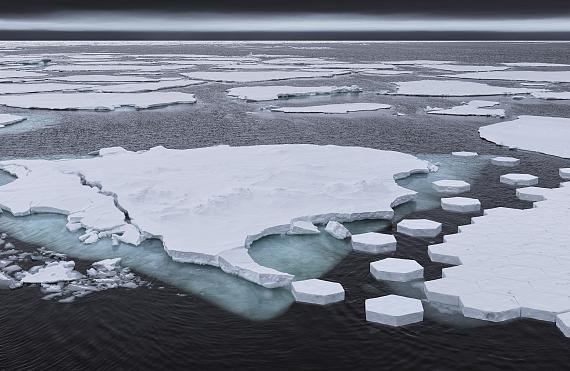
stratospheric injection, 2022
Format 1: 132 x 202 cm, edition of 6 + 2 AP
Format 2: 67 x 102 cm, edition of 6 + 2 AP
Hybrid photography, archival pigment print, aludibond, diasec
custom-made wood/ aluminium frame
Michael Najjar »
cool earth
Exhibition: 26 Nov 2022 – 14 Jan 2023
Sat 26 Nov 11:30

Studio la Citta
Lungadige Galtarossa 21
37133 Verona
+39 045-597549
lacitta@studiolacitta.it
www.studiolacitta.it
Mon 14-18, Tue-Fri 9-13 + 14-18, Sat 9-13

eruption, 2021
Format 1: 130 x 108 | 132 x 200 | 132 x 108 cm, edition of 6 + 2 AP
Format 2: 65 x 54 | 65 x 100 | 65 x 54 cm, edition of 6 + 2 AP
Hybrid photography, archival pigment print, aludibond, diasec
custom-made wood/ aluminium frame
Michael Najjar
"cool earth"
Exhibition: 26 November 2022 – 14 January 2023
Opening: Saturday, 26 November, 11:30 am
Michael Najjar’s latest work series "cool earth" deals with our planetary future in times of climate change, and the role of new climate technologies. It explores the far-reaching ecological, economic and cultural impacts of human-induced climate change which are leading to a redefinition of the relationship between humans and nature. In the Anthropocene era humans have become the major transformative force in the Earth system which is fast approaching its breaking point. Humans are now transforming nature hundreds of thousands of years into the future; the natural environment is being changed into a post-natural landscape; the technosphere is enveloping our planet and increasingly expanding into space. It now weighs more than the entire biomass of the planet. We are fast approaching a time when the technical will contend with the natural for the future shape of the world. Synthesis will determine the future of the planet.
Ever since Alexander von Humboldt we have known that the Earth is a complex self-regulating system in which everything is connected with everything else. Biophysical processes link the polar regions with equatorial regions; local weather systems interact with global precipitation systems; the oceans exchange energy with the atmosphere; biodiversity stabilises our ecosystems. Science has defined nine planetary boundaries in our Earth system: climate change, stratospheric ozone depletion, the rate of biodiversity loss, chemical pollution, acidification of oceans, consumption of freshwater, changes in land use, nitrogen and phosphorous pollution. These boundaries define a safe biophysical margin of action within which a stable and resilient planet is guaranteed. If these limits are exceeded, we enter a high-risk area of irreversible change. Four of these limits have already been crossed. Consequentially, if tipping points occur in many systems and places at once, the combined impact could lead to catastrophic feedback effects on a planetary scale. The increase in the Earth’s temperature by over 2 degrees would activate such tipping points. A hitherto stable system would turn into a chaotic one and endanger human civilisation.
To prevent this from happening, we must completely decarbonise our energy cycle as rapidly as possible. Should the output of greenhouse gases remain at its present level, science tells us that we are heading straight to climate collapse. It’s not just about acting fast, it’s about thinking big and innovatively. We need sustainable food systems, economic cycle models, and emission-free transport and energy systems. But such a transition to greater sustainability in these areas can only be reached through technology and systems innovation. If we want to avoid triggering dangerous tipping points as Earth’s answer to anthropogenic impacts, we need to find new ways to achieve food security and growth in a fossil-free world without further damaging other life forms.
In view of the dramatic consequences of climate change for future generations, there is a need to set new perspectives in the ways we think about technology, aesthetics and culture. We must think beyond the principle of sustainability to the active restoration of our damaged environment. The greenhouse gases emitted in excess by industrialisation over the past 150 years must be absorbed and stored. To counteract the encroaching climate emergency and the existential threat to our planet’s ecosystem, scientists are increasingly weighing up the possibilities of large-scale technical interventions in the Earth’s natural systems, so-called climate engineering. The term refers to pin-pointed technical interventions in the Earth’s geo- and biochemical cycles, in the oceans, in the ground and in the atmosphere. Measures such as active CO₂ absorption from the air and subsequent carbonisation in the ground, injection of aerosols into the stratosphere to change the radiation budget, space reflectors, brightening of clouds, targeted modification of the weather, fertilisation of the oceans, artificial production of polar ice, modification of deserts, ocean farming, and large scale afforestation all belong to the instruments of climate engineering. Although many approaches are still theoretical in nature and we know little about the global impact of such interventions, in a world that is 2 degrees warmer, such tools may well prove indispensable.
The work series "cool earth" spans the arc from an impending dystopian future - which has already arrived in our present – to a technology-based decarbonised post-fossil world. It picks up on ideas already addressed in Najjar’s previous series of works "outer space" such as terraforming and the re-surveying of Earth’s systems from orbit. The political, cultural and technical means to deal with the climate crisis lie within our grasp, yet we continue to head for the abyss. Why do we hesitate? Perhaps because the climate crisis appears to us as a hyperobject whose complexity and temporal and spatial dimensions lie beyond our understanding. An artistic confrontation with this hyperobject could contribute to making invisible connections visible, to setting processes of reflection in motion, and to visualising post-fossil visions of the future. The works of the "cool earth" series are a resonance body connecting scientific knowledge with aesthetic construction. The photos and video works open up a field of thought to viewers on how we can design a liveable, post-destructive world within our planetary boundaries.

floating generators, 2022
Format 1: 132 x 202 cm / 52 x 79.5 in, edition of 6 + 2 AP
Format 2: 67 x 102 cm / 26.3 in x 40.2, edition of 6 + 2 AP
Hybrid photography, archival pigment print, aludibond, diasec
custom-made wood/ aluminium frame
Michael Najjar
"cool earth"
Ausstellung: 26. November 2022 bis 14. January 2023
Eröffnung: Samstag, 26. November, 11:30 Uhr
Michael Najjars neuste Werkserie "cool earth" setzt sich mit unserer planetaren Zukunft in Zeiten des Klimawandels sowie der Rolle neuer Klimatechnologien auseinander. Sie thematisiert die weitreichenden ökologischen, ökonomischen und kulturellen Auswirkungen des vom Menschen verursachten Klimawandels, welcher zu einer Neudefinition der Beziehung zwischen Mensch und Natur führt. Im Zeitalter des Anthropozäns ist der Mensch zur wichtigsten Transformationskraft im System Erde geworden, welches zunehmend an seine Belastungsgrenzen stößt. Der Mensch verändert jetzt die Natur auf Hunderttausende von Jahren in die Zukunft, die natürliche Umgebung wird in post-natürliche Landschaften transformiert, die Technosphäre umhüllt unseren Planeten und weitet sich zunehmend in den Weltraum aus. Sie wiegt inzwischen mehr als die gesamte Biomasse des Planeten. Wir nähern uns einer Zeit, in der das Technische mit dem Natürlichen um die zukünftige Gestalt der Welt ringt. Die Synthese bestimmt die Zukunft des Planeten.
Seit Alexander von Humboldt wissen wir, dass die Erde ein komplexes und sich selbst regulierendes System ist, in dem alles mit allem verbunden ist. Biophysikalische Prozesse verknüpfen die Polarregionen mit den äquatorialen Gebieten, lokale Wettersysteme wechselwirken mit den globalen Niederschlagssystemen, die Ozeane stehen im Energieaustausch mit der Atmosphäre, die Artenvielfalt stabilisiert unsere Ökosysteme. Die Wissenschaft hat neun planetarische Grenzen in unserem Erdsystem definiert: Klimawandel, stratosphärischer Ozonabbau, Verlustrate der biologischen Artenvielfalt, chemische Verschmutzung, Meeresversauerung, Süßwasserverbrauch, Landnutzungsänderung, Stickstoff- und Phosphorverschmutzung. Diese Grenzen definieren einen sicheren biophysikalischen Handlungsspielraum, innerhalb dessen ein stabiler und belastbarer Planet gewährleistet ist. Werden diese Grenzen überschritten, treten wir in einen Hochrisikobereich mit unumkehrbarem Wandel ein. Vier dieser Grenzen sind inzwischen überschritten. Wenn infolgedessen Kipppunkte in zu vielen Systemen und an zu vielen Orten gleichzeitig eintreten, können die kombinierten Auswirkungen zu katastrophalen Rückkopplungseffekten in planetarischem Ausmaß führen. Der Anstieg der Erdtemperatur auf über 2 Grad würde diverse solcher Kipppunkte im Erdsystem aktivieren, ein bislang stabiles System würde sich in ein chaotisches verwandeln und die menschliche Zivilisation gefährden.
Um dies zu verhindern, müssen wir unseren Energiekreislauf schnellstmöglich vollständig dekarbonisieren. Bleibt der Ausstoß von Treibhausgasen auf dem jetzigen Niveau, steuern wir laut Wissenschaft auf den Klimakollaps zu. Es geht nicht nur um schnelles Handeln, sondern auch darum, groß und innovativ zu denken. Wir benötigen nachhaltige Nahrungsmittelsysteme, wirtschaftliche Kreislaufmodelle und emissionsfreie Transport- und Energiesysteme. Einen Übergang zu mehr Nachhaltigkeit können wir in diesen Bereichen nur durch Technologie- und Systeminnovation erreichen. Wenn wir die Auslösung gefährlicher Kipppunkte als Antwort der Erde auf die anthropogenen Einwirkungen vermeiden wollen, müssen wir neue Wege finden, um Nahrungsmittelsicherheit und Wachstum in einer Welt ohne fossile Energie zu erreichen und dürfen dabei andere Lebensformen nicht weiter schwächen.
Angesichts der dramatischen Folgen des Klimawandels für zukünftige Generationen bedarf es technischer, ästhetischer und kultureller Neuperspektivierungen. Wir müssen dabei über das Prinzip der Nachhaltigkeit hinausdenken, hin zur aktiven Restaurierung unserer beschädigten Umwelt. Das in den letzten 150 Jahren durch die Industrialisierung im Übermaß ausgestoßene CO₂ und Methan muss absorbiert und gespeichert werden. Um dem fortschreitenden Klimanotstand und der existenziellen Bedrohung unseres planetaren Ökosystems entgegenzuwirken, diskutieren Wissenschaftler zunehmend auch die Möglichkeiten großräumiger technischer Eingriffe in die natürlichen Erdsysteme, das sogenannte Climate-Engineering. Der Begriff bezeichnet gezielte technische Interventionen in geo- und biochemische Kreisläufe der Erde, in die Ozeane, in die Böden und in die Atmosphäre. Maßnahmen wie aktive CO₂ Absorption aus der Luft und anschließender Karbonisierung im Boden, Einbringung von Aerosolen in die Stratosphäre zur Veränderung des Strahlungshaushaltes, Weltraumreflektoren, Aufhellung von Wolken, gezielte Wetterveränderung, Düngung der Ozeane, künstliche Produktion von Polareis, Wüstenmodifikation, Ocean-Farming und großskalige künstliche Aufforstung gehören zu den Instrumenten des Climate-Engineerings. Obwohl viele Ansätze noch theoretischer Natur sind und wir wenig über die globalen Auswirkungen solcher Eingriffe wissen, werden in einer 2 Grad wärmeren Welt diese Instrumente möglicherweise unverzichtbar.
Die Werkserie "cool earth" spannt den Bogen von einer drohenden dystopischen Zukunft – die bereits in der Gegenwart angekommen ist – hin zu einer zu technologiebasierten, dekarbonisierten, post-fossilen Welt. Sie führt Ideen fort, die bereits in Najjars vorheriger Werkserie "outer space" thematisiert wurden, wie beispielsweise das Terraforming und die Neuvermessung der Erdsysteme aus dem Orbit. Politische, kulturelle und technische Mittel zur Bewältigung der Klimakrise liegen in greifbarer Nähe, dennoch steuern wir weiter Richtung Abgrund. Warum zögern wir? Vielleicht weil uns die Klimakatastrophe als Hyperobjekt erscheint, dessen Komplexität, seine zeitlichen und räumlichen Dimensionen für uns nicht fassbar sind. Eine künstlerische Auseinandersetzung mit diesem Hyperobjekt kann dazu beitragen, unsichtbare Zusammenhänge sichtbar zu machen, Reflexionsprozesse in Gang zu setzen und postfossile Zukunftsvisionen zu visualisieren. Die Werke der "cool earth" Serie sind ein Resonanzkörper der wissenschaftliche Erkenntnis mit ästhetischer Konstruktion verbindet. Die Bilder und Videoarbeiten eröffnen dem Betrachter ein Denkfeld von Möglichkeiten, wie wir eine lebenswerte, postdestruktive Welt innerhalb unserer planetarischen Grenzen gestalten können.

silk leaf, 2022
Format 1: 202 x 132 cm, edition of 6 + 2 AP
Format 2: 102 x 67 cm, edition of 6 + 2 AP
Hybrid photography, archival pigment print, aludibond, diasec
custom-made wood/ aluminium frame

polar amplification, 2022
Format 1: 132 x 202 cm, edition of 6 + 2 AP
Format 2: 67 x 102 cm, edition of 6 + 2 AP
Hybrid photography, archival pigment print, aludibond, diasec
custom-made wood/ aluminium frame